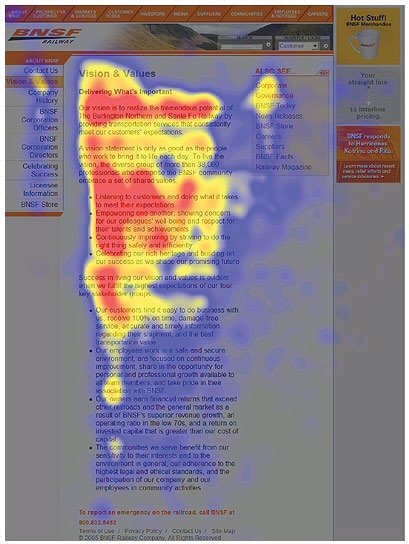- Do not repeat segments of the list items
- Keep line-lengths similar
- Highlight Keywords within the list
No One Reads Your Content
Use Neuroscience and UX Research To Increase Marketing Effectiveness
No one reads your content. That’s a fact. It is also a fact that you can use that information to communicate more effectively.
In the late 1990s we learned that people mostly just scan text on a web page (Link). Nearly eighty percent of people fall into this category. They seldom read word for word, as if the page was a novel open before them. That fact hasn’t changed in the twenty-five years since the first research was completed. Even today, with smart phones and high resolution screens, people scan web pages.
Patterns: How People Engage With Content

People scan text online. Understanding this fact means we can design for it to get the desired results. Most visitors to a web page scan text in a recognizable pattern. The most prevalent is the F-pattern (see Image), beginning from the top-left and moving right then down the page. As they move to the right they scan less intensely, focusing primarily on words at the beginning of the line of text.
What Works As People Scan Down the Page
Highlight Keywords and Phrases
There are several ways to get attention and engage readers as they scan your page. The first is to highlight keywords and phrases. Highlighted keywords grab our attention and make us take notice. This also applies to Links, especially if there is a good contrast between the page text color and the link color.
Highlighting Keywords, Phrases, and Links has a big impact on what people focus on as they scan a web page. However, two areas garner a lot of attention and focus of readers and should be emphasized: the use of sub-headers and lists.
Use Frequent Sub-Headers
The frequent use of sub-headers (H4 and H5 headers) inform readers of what the next section of content is about. It is important that the sub-headers be descriptive. Remember, these are areas readers are focused on. Use them to communicate in a manner that will make them want to read more than they normally scan. Sub-headers can be used before each new idea.
Bulleted Lists Get Noticed
Lists are great at getting attention and they are easy to scan. But they have to be constructed properly. Plan and design lists that engage people:
Be Aware Of The Layer Cake Reading Pattern

There is one other reading pattern that is important, especially on Content pages (as opposed to blog posts): The Layer Cake pattern. Readers often scan a page in chunks. In the Layer Cake pattern readers scan from left to right, then down to the next level and back to the left (See image). To communicate with them it is important to break up the page into a recognizable pattern: Content - Image - Content - Image, etc. Keep in mind that the images need to enhance the chunk content.
The Layer Cake Pattern
- Use sub-headers for each chunk
- Keep the chunk content brief
- Break up chunks with imagery
- Enhance the content with images
Two Other Factors: Jargon and Characters
None of the above information will make a difference if you don’t understand two other factors regarding human interaction and reading: understand human limitations and avoid industry jargon.
How We Read
Humans aren’t good at tracking more than seventy-five characters wide when reading. We lose our place when attempting to track back to the next line and, eventually, we lose interest. A lot of design today ignores this and you can find websites throughout the internet where text is stretched across the page with paragraphs that are nearly impossible for us to read. Keep line lengths to no more than seventy-five characters.
Avoid Industry Jargon
Visitors to your web page want something unique, different. They want to understand how you can change their world. Using a lot of industry jargon makes you sound like everyone else and turns people away. Literally, jargon impacts the bounce rate of a page. Understand your corporate voice and communicate in as simple and straight-forward manner as possible without a lot of industry jargon and buzzwords. Visitors to your website are busy. They want facts and valuable information without a lot of noise.
Conclusion
As was stated at the beginning of this article, no one reads your content. They scan it. Plan for that. Design for it. Construct content that takes advantage of it. In the end, you will communicate more clearly and effectively.







 Jack McDaniel has been a great resource to CognitiveScale. He has helped build out a new website, write content, and develop a management dashboard to help us track Marketing KPIs. He quickly understood our business and contributed to writing and editing content, which has always been a challenge for us given the complexity of our technology. Jack was able to dive right in and contribute to our new messaging, and then translate this to SEO, advertising, and a number of Marketing campaigns. And his work drove results that were very valuable."
Jack McDaniel has been a great resource to CognitiveScale. He has helped build out a new website, write content, and develop a management dashboard to help us track Marketing KPIs. He quickly understood our business and contributed to writing and editing content, which has always been a challenge for us given the complexity of our technology. Jack was able to dive right in and contribute to our new messaging, and then translate this to SEO, advertising, and a number of Marketing campaigns. And his work drove results that were very valuable."
